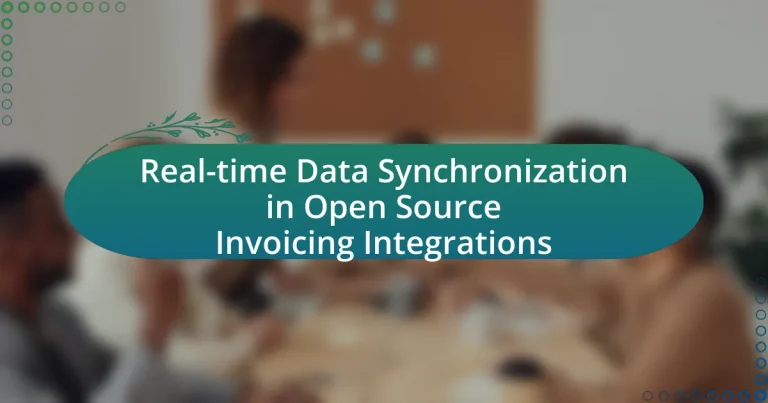Real-time data synchronization in open source invoicing integrations is the process of continuously updating data across various systems as transactions occur, ensuring accuracy and operational efficiency. This article explores how real-time synchronization functions through APIs, the technologies that enable it, and the benefits it provides, such as improved data accuracy and enhanced decision-making. It also addresses challenges like data consistency and network latency, while offering best practices for successful implementation and maintenance. Additionally, the article discusses future trends, including the role of artificial intelligence and automation in optimizing synchronization processes.

What is Real-time Data Synchronization in Open Source Invoicing Integrations?
Real-time data synchronization in open source invoicing integrations refers to the immediate and continuous updating of data across multiple systems or platforms as transactions occur. This process ensures that all invoicing information, such as payments, customer details, and inventory levels, is consistently accurate and up-to-date in real-time, minimizing discrepancies and enhancing operational efficiency. For instance, when a payment is processed in an invoicing system, real-time synchronization allows that information to be instantly reflected in related systems, such as accounting or inventory management software, thereby facilitating seamless business operations and improving decision-making.
How does real-time data synchronization function within open source invoicing integrations?
Real-time data synchronization in open source invoicing integrations functions by continuously updating and exchanging data between the invoicing software and other connected systems, such as accounting or CRM platforms. This process typically utilizes APIs (Application Programming Interfaces) to facilitate instant data transfer, ensuring that any changes made in one system, such as invoice creation or payment updates, are immediately reflected in the other systems. For example, when an invoice is generated in the invoicing software, the API sends this information to the accounting system in real-time, maintaining data consistency across platforms. This capability is crucial for businesses that rely on accurate and up-to-date financial information to make informed decisions and streamline operations.
What are the key technologies enabling real-time data synchronization?
Key technologies enabling real-time data synchronization include WebSockets, Change Data Capture (CDC), and message brokers like Apache Kafka. WebSockets facilitate two-way communication between clients and servers, allowing for instant data updates. Change Data Capture monitors and captures changes in databases, ensuring that updates are propagated in real-time. Message brokers, such as Apache Kafka, enable the efficient transmission of data streams between systems, supporting high-throughput and low-latency data synchronization. These technologies collectively enhance the responsiveness and accuracy of data synchronization processes in various applications, including open-source invoicing integrations.
How does real-time synchronization differ from batch processing?
Real-time synchronization involves continuous data updates as changes occur, while batch processing collects data over a period and processes it at scheduled intervals. In real-time synchronization, data is instantly reflected across systems, enabling immediate access and decision-making, which is crucial for applications like invoicing where timely information is essential. In contrast, batch processing may lead to delays in data availability, as updates are only applied after the batch is processed, potentially hindering responsiveness in dynamic environments.
What are the primary benefits of implementing real-time data synchronization?
The primary benefits of implementing real-time data synchronization include improved data accuracy, enhanced decision-making, and increased operational efficiency. Real-time data synchronization ensures that all systems reflect the most current information, reducing discrepancies and errors that can arise from outdated data. This accuracy enables organizations to make informed decisions quickly, as they have access to the latest data insights. Furthermore, operational efficiency is enhanced because processes can be streamlined, reducing the time spent on manual data entry and reconciliation. According to a study by Gartner, organizations that implement real-time data synchronization can see a 30% increase in productivity due to these efficiencies.
How does real-time synchronization enhance user experience in invoicing?
Real-time synchronization enhances user experience in invoicing by ensuring that all data is consistently updated across platforms, which minimizes errors and improves efficiency. When users generate or modify invoices, real-time synchronization allows immediate reflection of these changes, enabling seamless collaboration among team members and clients. This capability reduces the likelihood of discrepancies, as all parties access the most current information, leading to faster decision-making and improved customer satisfaction. Studies show that businesses utilizing real-time data synchronization experience a 20% increase in operational efficiency, highlighting its significant impact on user experience in invoicing.
What cost savings can businesses expect from real-time data synchronization?
Businesses can expect significant cost savings from real-time data synchronization, primarily through reduced operational inefficiencies and minimized errors. By ensuring that data is consistently updated across all platforms, companies can eliminate the need for manual data entry, which can save an average of $4,000 per employee annually, according to a study by the American Management Association. Additionally, real-time synchronization helps prevent costly mistakes that arise from outdated or inaccurate information, which can lead to financial losses and damage to customer relationships. Furthermore, businesses can enhance decision-making speed and accuracy, leading to improved resource allocation and reduced overhead costs.

What challenges are associated with real-time data synchronization in open source invoicing?
Real-time data synchronization in open source invoicing faces several challenges, including data consistency, network latency, and integration complexity. Data consistency issues arise when multiple users or systems update the same data simultaneously, leading to conflicts and inaccuracies. Network latency can hinder the speed of data updates, causing delays that affect the reliability of real-time transactions. Additionally, integration complexity stems from the need to connect various systems and platforms, which may have different data formats and protocols, complicating the synchronization process. These challenges can significantly impact the effectiveness of real-time invoicing solutions.
What common technical issues arise during implementation?
Common technical issues that arise during the implementation of real-time data synchronization in open source invoicing integrations include data inconsistency, latency, and integration complexity. Data inconsistency occurs when different systems have conflicting information, which can lead to errors in invoicing and reporting. Latency issues may arise due to network delays or inefficient data processing, resulting in outdated information being displayed. Integration complexity often stems from varying data formats and protocols used by different systems, making it challenging to achieve seamless communication. These issues are frequently documented in case studies and technical reports, highlighting their prevalence in real-world implementations.
How can data integrity be maintained during synchronization?
Data integrity can be maintained during synchronization by implementing robust validation mechanisms and ensuring consistent data formats across systems. Validation mechanisms, such as checksums or hash functions, can verify that data remains unchanged during transfer, while consistent data formats prevent discrepancies that could lead to integrity issues. For instance, using a standardized API for data exchange can minimize errors and ensure that all systems interpret the data uniformly. Additionally, employing transaction logs can help track changes and facilitate rollback in case of synchronization failures, thereby preserving data integrity.
What are the security concerns related to real-time data synchronization?
Real-time data synchronization poses several security concerns, primarily including data breaches, unauthorized access, and data integrity issues. Data breaches can occur when sensitive information is transmitted over unsecured channels, making it vulnerable to interception by malicious actors. Unauthorized access may arise if proper authentication mechanisms are not implemented, allowing individuals without permission to access or manipulate data. Additionally, data integrity issues can result from synchronization errors or tampering during transmission, leading to inconsistencies and potential loss of trust in the data’s accuracy. These concerns highlight the necessity for robust encryption, secure authentication protocols, and thorough validation processes in real-time data synchronization systems.
How can organizations overcome these challenges?
Organizations can overcome challenges in real-time data synchronization in open source invoicing integrations by implementing robust middleware solutions that facilitate seamless data exchange. Middleware acts as a bridge between different systems, ensuring that data is consistently updated across platforms. For instance, using tools like Apache Kafka or RabbitMQ can enhance data flow and reduce latency, as they are designed for real-time data processing. Additionally, organizations should adopt standardized APIs to ensure compatibility and ease of integration, which can significantly minimize integration issues. Research indicates that companies utilizing standardized APIs experience a 30% reduction in integration time, leading to more efficient operations.
What best practices should be followed for successful implementation?
Successful implementation of real-time data synchronization in open source invoicing integrations requires thorough planning, clear communication, and robust testing. First, organizations should define clear objectives and requirements for the synchronization process, ensuring alignment with business goals. Next, employing standardized protocols such as RESTful APIs or WebSockets enhances compatibility and efficiency. Additionally, implementing error handling and logging mechanisms is crucial for identifying and resolving issues promptly. Regular testing in a controlled environment before full deployment minimizes risks and ensures system reliability. According to a study by the International Journal of Information Management, organizations that follow structured implementation practices experience a 30% reduction in integration errors, highlighting the importance of these best practices.
How can organizations ensure ongoing maintenance and support?
Organizations can ensure ongoing maintenance and support by implementing a structured approach that includes regular updates, dedicated support teams, and user training. Regular updates are essential to address security vulnerabilities and improve functionality, which is particularly important in open source environments where community contributions can introduce changes. Dedicated support teams provide immediate assistance and troubleshooting, ensuring that issues are resolved quickly to minimize downtime. User training enhances the ability of staff to utilize the invoicing system effectively, reducing reliance on external support. According to a study by the Open Source Initiative, organizations that invest in these areas experience a 30% reduction in operational disruptions, highlighting the effectiveness of a proactive maintenance strategy.

What are the future trends in real-time data synchronization for open source invoicing?
Future trends in real-time data synchronization for open source invoicing include increased adoption of cloud-native architectures, enhanced API integrations, and the use of machine learning for predictive analytics. Cloud-native architectures facilitate seamless data access and scalability, allowing invoicing systems to synchronize data in real-time across multiple platforms. Enhanced API integrations enable better interoperability between different software solutions, ensuring that invoicing data is consistently updated and accurate. Additionally, machine learning algorithms can analyze transaction patterns to optimize invoicing processes and improve cash flow management. These trends are supported by the growing demand for efficient financial management solutions and the increasing complexity of business operations, which necessitate real-time data accuracy and accessibility.
How is artificial intelligence influencing real-time data synchronization?
Artificial intelligence is enhancing real-time data synchronization by enabling predictive analytics and automated decision-making processes. AI algorithms analyze data patterns and trends, allowing systems to anticipate changes and synchronize data across platforms more efficiently. For instance, machine learning models can identify discrepancies in data streams and automatically correct them, reducing latency and improving accuracy. This capability is crucial in open source invoicing integrations, where timely and accurate data is essential for financial transactions and reporting. Studies have shown that organizations implementing AI-driven synchronization solutions experience up to a 30% reduction in data errors and a significant increase in operational efficiency.
What role does machine learning play in improving synchronization processes?
Machine learning enhances synchronization processes by enabling predictive analytics and anomaly detection. These capabilities allow systems to anticipate data changes and identify discrepancies in real-time, thereby improving the accuracy and efficiency of data synchronization. For instance, machine learning algorithms can analyze historical data patterns to predict when updates are likely to occur, allowing for proactive synchronization rather than reactive measures. Additionally, by employing techniques such as clustering and classification, machine learning can detect outliers or errors in data streams, ensuring that only accurate and relevant information is synchronized. This results in reduced latency and improved reliability in open source invoicing integrations, ultimately leading to a more seamless user experience.
How can automation enhance the efficiency of real-time data synchronization?
Automation enhances the efficiency of real-time data synchronization by streamlining processes, reducing human error, and enabling faster data updates. Automated systems can continuously monitor data changes and instantly propagate those changes across integrated platforms, ensuring that all systems reflect the most current information. For instance, a study by McKinsey & Company found that automation can reduce data processing time by up to 80%, significantly improving the speed and accuracy of data synchronization. This efficiency is crucial in open source invoicing integrations, where timely and accurate financial data is essential for operational success.
What practical steps can businesses take to implement real-time data synchronization effectively?
Businesses can implement real-time data synchronization effectively by adopting a robust integration platform that supports APIs and webhooks. Utilizing these technologies allows for seamless data exchange between systems, ensuring that updates are reflected instantly across all platforms. For instance, a study by MuleSoft found that organizations using API-led connectivity can achieve a 50% reduction in integration time, demonstrating the efficiency of this approach. Additionally, businesses should establish data governance policies to maintain data quality and consistency, as poor data quality can undermine synchronization efforts. Implementing monitoring tools to track data flow and identify discrepancies in real-time further enhances the effectiveness of synchronization processes.
What tools and platforms are recommended for open source invoicing integrations?
Recommended tools and platforms for open source invoicing integrations include Invoice Ninja, Dolibarr, and Odoo. Invoice Ninja offers a user-friendly interface and supports multiple payment gateways, making it suitable for small to medium-sized businesses. Dolibarr is a comprehensive ERP and CRM solution that includes invoicing features, allowing for seamless integration with other business processes. Odoo provides a modular approach, enabling users to customize their invoicing system according to specific business needs. These platforms are widely recognized for their flexibility and community support, ensuring effective real-time data synchronization in invoicing processes.
How can businesses measure the success of their synchronization efforts?
Businesses can measure the success of their synchronization efforts by analyzing key performance indicators (KPIs) such as data accuracy, synchronization speed, and user satisfaction. Data accuracy can be assessed by comparing the consistency of synchronized data across systems, with a target accuracy rate of 95% or higher being ideal. Synchronization speed can be evaluated by measuring the time taken to update data across platforms, with faster synchronization leading to improved operational efficiency. User satisfaction can be gauged through surveys or feedback mechanisms, aiming for a satisfaction score of 80% or above. These metrics provide concrete evidence of the effectiveness of synchronization efforts in real-time data synchronization within open source invoicing integrations.




